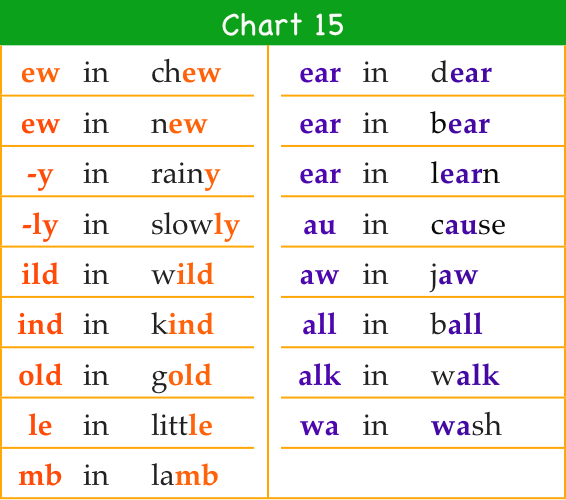Learning English – Step by Step
Key Words:
Letters and Sounds first. Then build letters into words and words into sentences!
When phonics is not taught on purpose, but rather as a ‘by-the-way’ component of a school curriculum, students may miss vital phonics elements which can result in hindered reading skills.
To be most effective, phonics also needs to be taught on a regularly scheduled basis: four to five days per week.
What is phonics?
Phonics is a method of teaching children to read by linking sounds (phonemes) and the symbols that represent them (graphemes, or letter groups). Phonics is the learning-to-read method used in primary schools in the UK today.
What is a phoneme?
A phoneme is the smallest unit of sound. The phonemes used when speaking English are:
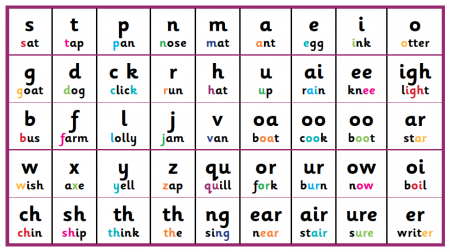
Print out a list of phonemes to practise with your child or listen to the individual sounds being spoken with our phonics worksheets.
Phonics learning step 1: decoding
Children are taught letter sounds in Reception. This involves thinking about what sound a word starts with, saying the sound out loud and then recognising how that sound is represented by a letter.
The aim is for children to be able to see a letter and then say the sound it represents out loud. This is called decoding.
Some phonics programmes start children off by learning the letters s, a, t, n, i, p first. This is because once they know each of those letter sounds, they can then be arranged into a variety of different words (for example: sat, tip, pin, nip, tan, tin, sip, etc.).
Phonics learning step 2: blending
Children then need to go from saying the individual sounds of each letter, to being able to blend the sounds and say the whole word. This can be a big step for many children and takes time.
While children are learning to say the sounds of letters out loud, they will also begin to learn to write these letters (encoding). They will be taught where they need to start with each letter and how the letters need to be formed in relation to each other. Letters (or groups of letters) that represent phonemes are called graphemes.
Phonics learning step 3: decoding CVC words
Children will focus on decoding (reading) three-letter words arranged consonant, vowel, consonant (CVC words) for some time. They will learn other letter sounds, such as the consonants g, b, d, h and the remaining vowels e, o, u. Often, they will be given letter cards to put together to make CVC words which they will be asked to say out loud.
Phonics learning step 4: decoding consonant clusters in CCVC and CVCC words
Children will also learn about consonant clusters: two consonants located together in a word, such tr, cr, st, lk, pl. Children will learn to read a range of CCVC words (consonant, consonant, vowel, consonant) such as trap, stop, plan. They will also read a range of CVCC words (consonant, vowel, consonant, consonant) such as milk, fast, cart.
Phonics learning step 5: vowel digraphs
Children are then introduced to vowel digraphs. A digraph is two vowels that together make one sound such as: /oa/, /oo/, /ee/, /ai/. They will move onto sounding out words such as deer, hair, boat, etc. and will be taught about split digraphs (or ‘magic e’). They will also start to read words combining vowel digraphs with consonant clusters, such as: train, groan and stool.
Phonics learning step 6: consonant digraphs
Children will also learn the consonant digraphs (two consonants that together make one sound) ch and sh and start blending these with other sounds to make words, such as: chat, shop, chain and shout.
Encoding, or learning to spell as well as read
Alongside this process of learning to decode (read) words, children will need to continue to practise forming letters which then needs to move onto encoding.
Encoding is the process of writing down a spoken word, otherwise known as spelling. They should start to be able to produce their own short pieces of writing, spelling the simple words correctly.
It goes without saying that reading a range of age-appropriate texts as often as possible will really support children in their grasp of all the reading and spelling of all the phonemes.
Phonics learning in KS1
By the end of Reception, children should be able to write one grapheme for each of the 44 phonemes.
In Year 1, they will start to explore vowel digraphs and trigraphs (a group of three letters that makes a single sound, like ‘igh’ as in ‘sigh’) further.
They will begin to understand, for example, that the letters ea can make different sounds in different words (dream and bread). They will also learn that one sound might be represented by different groups of letters: for example, light and pie (igh and ie make the same sound).
Children in Year 2 will be learning spelling rules, such as adding suffixes to words (such as -ed, -ing, -er, -est, -ful, -ly, -y, -s, -es, -ment and -ness).
They will be taught rules on how to change root words when adding these suffixes (for example, removing the ‘e’ from ‘have’ before adding ‘ing’) and then move onto harder concepts, such as silent letters (knock, write, etc) and particular endings (le in bottle and il in fossil).
_________________________________________________________________________________
Phonics Steps in Sequence
Cluster 1:
Step 1:Introduce the vowels and their short sounds. [Chart 1]
Step 2:Introduce the consonants and their sounds. [Chart 2]
Step 3:Begin blending short vowels with consonants. [Chart 3]
Step 4:Begin blending and reading one vowel words and short sentences. [Chart 4]
Cluster 2:
Step 5:Introduce the long vowel sounds. [Chart 5]
Step 6:Practice blending long vowels with consonants. [Chart 6]
Cluster 3:
Step 7:Begin blending and reading two vowel words and Introduce two special rules. [Charts 7 A, B]
Rule #1: The One Vowel Rule — Rule #2: The Two Vowel Rule
Step 8:Introduce the Phonics Charts which include the special sounds that are made when letters “stick” together. [Charts 8-17]
To begin your phonics adventure, please click on the link for Step 1.
Phonics Steps
_____________________________________________________________
Phonics Charts
The Phonics Charts on our site are meant to be used in conjunction with our Phonics Steps. The charts can be downloaded in accordance with our Terms of Use. The charts may be used for initial instruction or for a structured review of the sounds and spellings used in systematic, sequential phonics programs. For suggestions on how to use the charts, please see our Phonics Steps page.
- Chart 1 Short Vowels
- Chart 2 Consonants
- Chart 3 SVC Blends
- Chart 4 One Vowel Words
- Chart 5 Long Vowels
- Chart 6 LVC Blends
- Chart 7 Two Vowel Words
- Chart 8 – 9
- Charts 10A & 10B
- Charts 11 – 13
- Charts 14 – 15
- Charts 16 – 18

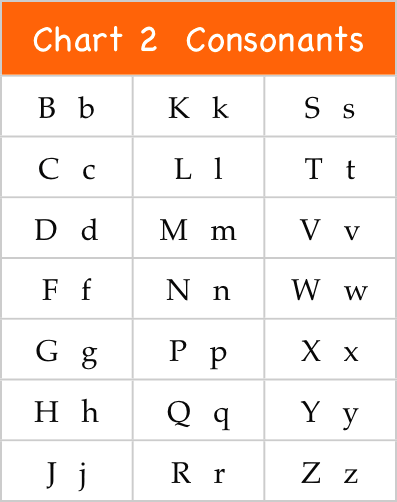









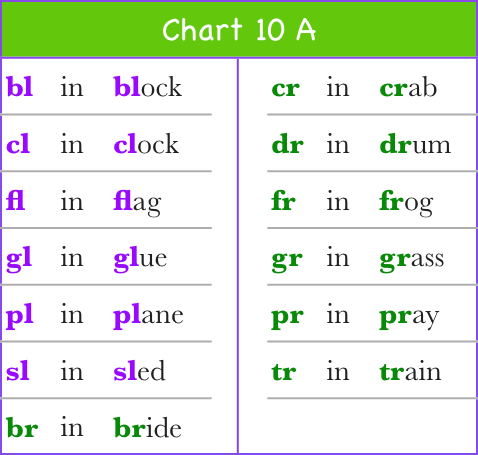
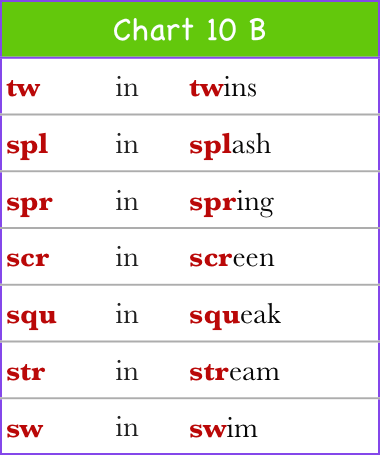




************************************************
Helpful Rules for Vowel Sounds and Spelling
A. Vowels
1. When there is only one vowel in a word, it usually says its short sound. man, den, pig, mop, dug
2. When there are two vowels in a word, the first vowel is usually long and the second
vowel is silent. make, seat, time, boat, cute
B. Basic Spelling Rules
1. I comes before ‘e’ except after ‘c’ or when sounding like ‘ay’ as in neighbor and weigh.
Exceptions: caffeine, codeine, counterfeit, either, foreign, forfeit, height, leisure, neither, protein, seize, seizure their, weird.
2. A /k/ sound at the end of a one syllable word with a short vowel is usually spelled with a ‘ck’ letter combination. pack, deck, kick, clock, duck
3. When ‘c’ comes before ‘e, i, and y,’ it usually has a soft /s/ sound. cent, city, cycle
4. When ‘c’ comes before ‘a, o, and u,’ it usually has a hard sound of /k/. can, cot, cup
5. When ‘g’ comes before ‘e, i, and y,’ it usually has a soft sound of /j/. gentle, gin, gym
6. When ‘g’ comes before ‘a, o, and u,’ it usually has a hard sound. game, got, gum
***********************************************
******************************************************************
****************************************************
Click to access Steps%20for%20Teaching%20Reading%20&%20Wrtiting%20with%20Jolly%20Phonics.pdf
Click to access Tricky%20Word%20ChecklistNEW.pdf
Click to access JPWB_Quick%20Contents.pdf
Click to access JPWB_Step%201%20Contents.pdf
Click to access JPWB_Step%202%20Contents.pdf
Click to access JPWB_Step%203%20Contents.pdf
Click to access Cartoonito+Group+1.pdf
Click to access Cartoonito+Group+2.pdf
Click to access Cartoonito+Group+3.pdf
Click to access Cartoonito+Group+4.pdf
Click to access Cartoonito+Group+5.pdf
Click to access Cartoonito+Group+6.pdf
Click to access Cartoonito+Group+7.pdf
Click to access Inky%20Colouring%20Sheet.pdf
Click to access Jolly%20Phonics%20Bee%20Colouring%20Sheet.pdf
Click to access Snake%20Colouring%20Sheet.pdf
Click to access Jolly%20Phonics%20ou%20colouring.sheet.pdf
Click to access Christmas%20Colouring%20Sheet.pdf
Click to access Finger%20Puppets.pdf
Click to access English%20Alphabetic%20Code.pdf
Click to access Jolly%20Phonics%20Pupil_Student%20Checklist.pdf
NCERT Books for Class 1 English
- Unit 1:
- Unit 2:
- Unit 3:
- Unit 4:
- Unit 5:
- Unit 6:
- Unit 7:
- Unit 8:
- Unit 9:
- Unit 10:
NCERT Class 1 English Marigold Book
Raindrops – 1
- Chapter 1: Clap, Clap, Clap
- Chapter 2: One, Two
- Chapter 3: The Little Bird
- Chapter 4: Bubbles
- Chapter 5: Chhotu
- Chapter 6: Animals and Birds
- Chapter 7: Fruits and Vegetables
- Chapter 8: Who Am I?
- Chapter 9: Hide and Seek
NCERT Class 1 English Raindrops Book
*************************************************************************
NCERT Books for Class 1 Maths in English Medium
Maths Magic – 1
- Chapter 1: Shapes and Space
- Chapter 2: Numbers from One to Nine
- Chapter 3: Addition
- Chapter 4: Subtraction
- Chapter 5: Number form Ten to Twenty
- Chapter 6: Time
- Chapter 7: Measurement
- Chapter 8: Numbers form Twenty-one to Fifty
- Chapter 9: Data Handling
- Chapter 10: Patterns
- Chapter 11: Numbers
- Chapter 12: Money
- Chapter 13: How Many
_________________________________________________________________
LKG Syllabus For CBSE, ICSE
Before getting into the details of LKG Syllabus, let’s look at the subjects under LKG:
| S. No. | List of Subjects |
| 1 | Maths or Mathematics |
| 2 | English |
| 3 | General Awareness |
| 4 | Environmental Science |
LKG Syllabus For Maths/Mathematics
The LKG Syllabus for Maths or Mathematics is tabulated below:
| CBSE Syllabus For Mathematics or Maths | Subject Wise Topics |
| Shapes | a) Identify circles, squares and trianglesb) Identify squares and rectangles |
| Count to 3 | a) Learn to count (up to 3)b) Count dots (up to 3)
c) Count shapes (up to 3) d) Count objects (up to 3) e) Count on ten frames (up to 3) f) Show numbers on ten frames (up to 3) |
| Count to 5 | a) Learn to count (up to 5)b) Count dots (up to 5)
c) Count shapes (up to 5) d) Count objects (up to 5) e) Count on ten frames (up to 5) f) Show numbers on ten frames (up to 5) g) Represent numbers (up to 5) |
| Count to 10 | a) Learn to count (up to 10)b) Count dots (up to 10)
c) Count shapes (up to 10) d) Count objects (up to 10) e) Count on ten frames (up to 10) f) Show numbers on ten frames (up to 10) g) Represent numbers (up to 10) |
| Comparing | a) Are there enough?b) Compare groups (fewer or more)
c) Fewer and more – compare by counting d) Compare in a mixed group |
| Positions | a) Inside and outsideb) Above and below
c) Beside and next to d) Left and right e) Left, middle and right f) Top and bottom g) Top, middle and bottom |
| Classify | a) Sameb) Different
c) Same and different d) Classify shapes by colour e) Classify and sort by colour f) Classify and sort by shape |
| Size | a) Long and shortb) Tall and short
c) Light and heavy d) Wide and narrow |
| Money | a) Coin valuesb) Count 1-rupee coins |
LKG Syllabus For English
The LKG Syllabus for English is tabulated below:
| LKG Syllabus For English | Subject Wise Topics |
Pre-writing Stokes |
a) Standing lineb) Sleeping line
c) Left Slanting line d) Right Slanting line e) Left Curve f) Right Curve g) Up Curve h) Down Curve |
Capital Letter (A-Z) |
a) Identificationb) Writing
c) Objects related to each letter |
Small Letter (a-z) |
a) Identificationb) Writing
c) Objects related to each letter d) Matching capital and small e) Vowels and Consonants f) Phonic Drill g) Vowel words h) Rhyming words to improve listening skills |
Phonetics |
a) Sound of lettersb) Objects related to letters
c) Vowels and Consonants d) Vowel words e) Article a/an f) This-That & These – those g) One- Many h) Positions i) Rhyming words j) Use of Genie board, flashcards, oral interaction, written work, worksheets, storytelling and enactment. |
LKG Syllabus For General Awareness
The LKG General Awareness Syllabus are tabulated below:
| General Awareness LKG Syllabus | Section Wise Topics |
About Myself |
a) Myselfb) My Body Parts
c) My Family d) My Birthday e) My Home f) My School |
Safety |
a) At homeb) On the road
c) At the Playground |
People Who Help Us |
a) Doctorb) Teacher
c) Policeman d) Postman e) Carpenter f) Farmer |
Transport |
a) Roadb) Rail
c) Air |
Seasons |
a) Summerb) Winter
c) Rainy |
Animal |
a) Wildb) Domestic
c) Water d) Pet |
LKG Syllabus For Environmental Science
The LKG Syllabus for Environmental Science is listed below:
- Good habits and manners.
- Project on collecting a few living and non-living things
- Introduction to traffic rules and safety
- Parts of the body
Now you are provided with all the necessary information regarding LKG Syllabus. We hope this detailed article helps you.
______________________________________________________________________
Best LKG Books 2020
Before getting into the details of LKG Books, let’s have an overview of a list of subjects covered under the Lower Kindergarten Curriculum:
- English
- Mathematics
- General Awareness
- Environmental Science
LKG English Books
There are several publications that offer English books based on LKG syllabus. The most preferred books by boards such as ICES or CBSE for LKG is given below:
| Book Name | Published By |
| Alphabet Practice Book Capital Letters | Jeevandeep Prakashan Pvt. Ltd. |
| Print Capital Letters | Grafalco |
| English for Toddlers A | Wonder Kids |
| Primary English (L.K.G.) | Sura Books |
English Books For Lower Kindergarten: Through English book, kids will be taught how to write uppercase and lowercase letters, Identification of letters, Rhymes, sounds, etc., Also kids will be taught how to write letters in different fonts.
LKG Maths Books
There are several publications which offer Mathematics book based on the prescribed Lower Kindergarten syllabus and they are tabulated below:
| Book Name/Title | Published By |
| Number Fun (3-5 Yrs) – A | Amity University Press |
| Mathematics Pre-Primer | Geetanjali Bakshi (Rachana Sagar Pvt Ltd) |
| Holy Faith Humming Bird Mathematics Primer -A | Govinda Ahuja |
| Pre School Numbers (1 to 50) | Grafalco |
Maths Books For Lower Kindergarten: Through the above-specified books, kids will be able to learn about the shapes, the difference between small and big. Along with it, children will also learn about numbers, basic addition and subtraction.
DOWNLOAD LKG WORKSHEETS PDF HERE
LKG Books For Environmental Science
The list of LKG EVS Books prescribed for the LKG Syllabus are tabulated below:
| Book Name | Title |
| Grafalco Pre-School EVS Activity Book – A | Grafalco |
| My Learning Train World Around Me Level I | Oxford University Press |
| Environmental Studies Books | Viva Young Learners |
| Humming Bird Environmental Studies-Intro | Govinda Ahuja |
Environmental Studies Books for Lowerkindergarten: Basically, the book helps children to be aware of his/her gender, needs. Along with that, kids will also learn about family, school, transports, seasons, etc., In general, EVS creates awareness about the surroundings of a Kid.
LKG Books for General Awareness
The Lower Kindergarten books for General Awareness are tabulated below:
| Book Name | Author/Publisher |
| Turtle Kindergarten Activity Sheets G.K. Level – 1 | Arrow Publications PVT.LTD. |
| Toddler Encourage independent Work GK Worksheets Book – LKG | Blackstone Books |
| Humming Bird General Knowledge-B | Govinda Ahuja |
Click to access 6D10B4370D2306806FCDD1DD3BF408C2.pdf
